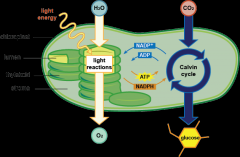![]()
![]()
![]()
Use LEFT and RIGHT arrow keys to navigate between flashcards;
Use UP and DOWN arrow keys to flip the card;
H to show hint;
A reads text to speech;
21 Cards in this Set
- Front
- Back
|
Cellular respiration (equation) |
C6H12O6 + 6O2 --> 6CO2 + 6H2O + ENERGY |
|
|
Cyanobacteria |
Bacteria create oxygen. Caused the Oxygen Revolution. |
|
|
Radiometric Dating vs. Relative Dating |
Radiometric dating is measuring the number of radioactive isotopes left in the dead organism. Using the "half life", or the amount of time for one half of the radioactive atoms to die, one can determine how old the organism is. Relative dating is determining where the remain is in a rock layer. If it is towards the bottom it is therefore older than anything above it, and vice versa. |
|
|
Stroma |
Liquid space inside the chloroplast. |
|
|
Granum |
A stack of thylakoid discs. |
|
|
Thylakoid |
Green disks inside the chloroplast with its own membranes. |
|
|
Photosynthesis (equation) |
6CO2 + 6H2O + ENERGY --> C6H12O6 + 6O2 |
|
|
Photosynthesis (diagram) |

|
|
|
Protozoans |
Protists that are heterotrophs. |
|
|
Algae |
Protists that are autotrophs. |
|
|
Zooflagellates |
Protists that can move via flagella. |
|
|
Pseudopodia |
A temporary extension of the cytoplasm to create movement. |
|
|
Forams |
Protozoans with porous shells made of organic material and calcium carbonate. |
|
|
Apiomplexans |
Protozoans that cannot move. |
|
|
Plasmodium |
A single mass of cytoplasm undivided by membrane or cell walls with multiple nuclei. A "super cell". |
|
|
Sporangia |
Bodies with tips that contain haploid cells that are dispersed to reproduce. |
|
|
Euglenoids |
Single-celled, photosynthetic, protists with flagella and no cell walls. |
|
|
Dinoflagellates |
Unicellular, mostly photosynthetic, protists with a cell wall made up of cellulose. |
|
|
Plankton |
Communities of microscopic organisms in water. |
|
|
Hyphae |
Tiny threads of cytoplasm covered by a cell wall made of chitin. |
|
|
Mycelium |
The large interwoven "mat" of a fungi underground. |

